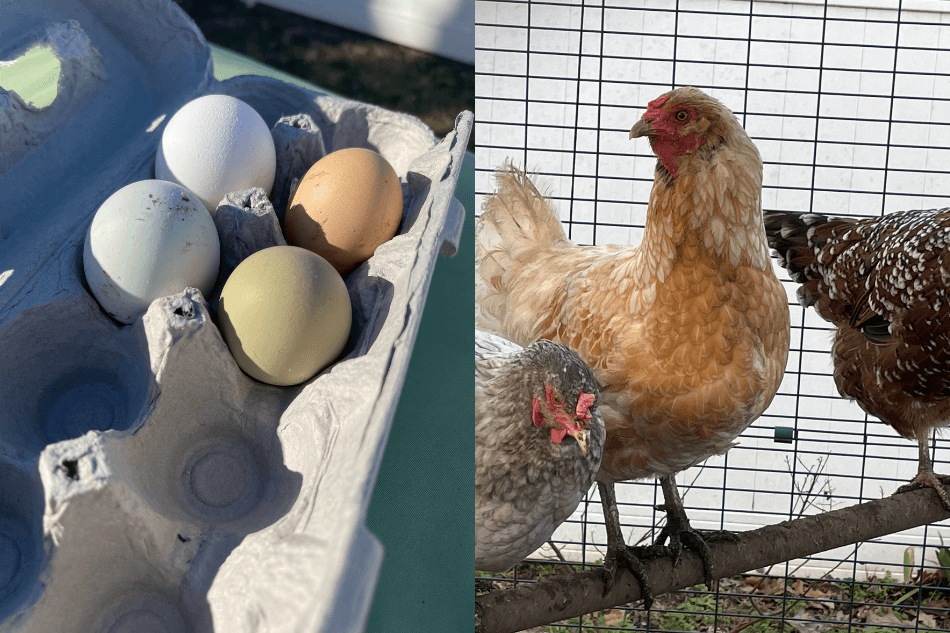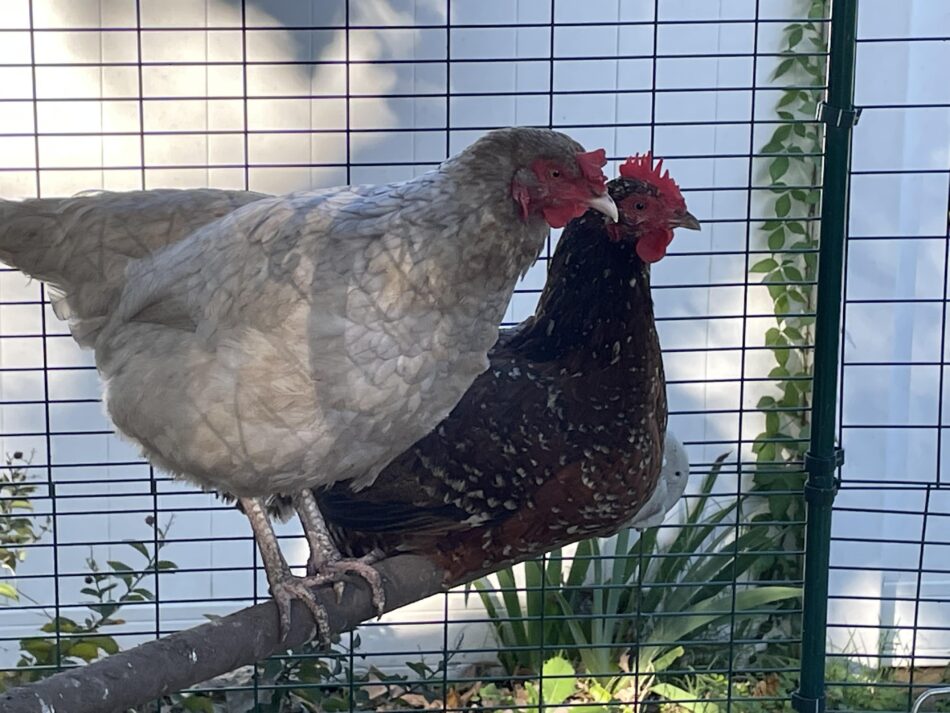A Day in the Life of a Chicken Tender
Miriam Drennan grew up on an organic farm with chickens, guineas, quail, cows, ponies, dogs, and any number of cats. She now lives in an urban neighbourhood in Nashville, Tennessee, and works as a freelance writer. She has had her current flock of hens for about two years. Even in an urban setting, she retains the practices her father taught her regarding how to care for the soil, plants, and creatures responsibly. It’s worth mentioning that her two rescue dogs, Anchor and Chance, are not much help around the house, and simply coast through life on their looks and charm. Miriam is also an enthusiastic Omlet ambassador, so if you happen to pass by Tennessee and are interested in any of the products she has – get in contact!
“What’s it like, raising urban chickens?”
I get this question a lot, once people learn that I have hens in my backyard, three miles from downtown Nashville, Tennessee. Thanks to the Omlet system, it’s quite easy.
My set-up is simple and stylish—the Eglu Go Up Chicken Coop and its adjacent Walk In Chicken Run are surrounded by the Omlet chicken fencing. No running water or electricity, but I have found a few hacks when the weather gets extreme.
So—what is it like, raising urban chickens? The timeline will shed a little light on what an average day might look like for me.
7:15 a.m. The sun is just beginning to stir, but not fully awake, which is a good time to refill the feeder with fresh food and replace the water in the drinker. It’s easier to do this before turning them out; I can leave the gate open and wander in and out freely, which comes in handy when you are lugging heavy containers and bags. My girls eat organic food, sprinkled with some herbal supplements to keep their yolks bright yellow and their immune systems healthy.
7:30 a.m. This will be a big morning for them, because they are getting their Free Standing Chicken Perch! Where to place it? Finally, I find a spot and insert the stakes—the rain we had recently helps them go in easy, then I add some dried mealworms to the treat tray that attaches to it.
7:45 a.m. It’s still a bit chilly this morning, so I add another layer of straw on the floor of their yard. They have scratched it bare, which is what chickens do, and the straw keeps their feet from getting too cold. In the summer, I switch to shredded pine mulch.
7:55 a.m. Next, I sprinkle their yard with grit and oyster shell for their gizzards and calcium intake, respectively. Chickens enjoy scratching for treasures, so it doesn’t matter if I leave these in small bowls or sprinkle throughout their yard.
By now, the girls are stirring—they know I’m there, and they’re ready to get out and play. Time to turn the crank . . . and out they come, like big feathered cannonballs shot out of a cannon (who needs steps when you have feathers?). As they fluff and flap, let me introduce them:
- Zuzu: A White Leghorn who looks brown because she likes to drink from mudpuddles. Although Zuzu is the smallest, she is the queen of the flock.
- Daisy: An Easter Egger and friendly, she is the largest in the crew.
- Dixie: An Olive Egger and shy; Dixie is a beautiful bluish-grey hen and her feathers are outlined in darker grey.
- Beaker: A Speckled Sussex and a bit of a rebel. Beaker’s finally getting tiny pops of brilliant green, purple, and blue feathers after this last molting.
8:10 a.m. As expected, Zuzu is the first to approach the perch tree, cocking her head a bit. She realizes this new “thing” in her yard has treats, so she’s good with that. Beaker is next, followed by Daisy. Dixie is shy; she hangs back and eventually, snatches a mealworm and runs back to safety.
I leave them to get acquainted with their new toy.
8:30–9:45 a.m. They sing their egg songs for all the neighborhood to hear. (Thankfully, my neighbors think it’s funny.)
10:00 a.m. Lawn Man has arrived to mow and trim, and as far as the girls are concerned, he is Public Enemy #1. They don’t like his noisy machines and they don’t like him in their yard, even though they are completely enclosed and safe in their Walk-in Run. After running around, trying to figure out where to escape Lawn Man’s motorized beast, they settle for the area underneath their coop. I recently enclosed this section with a few Omlet Heavy Duty Tarps as another place they can use for privacy. They love it. It’s a great little space for dust baths, running from the Scary Evil Snow that falls, or just to gather and cluck. Only Zuzu dares to walk out and challenge Lawn Man, who tips his hat to her and mows on.
12:00 p.m. I have time between work calls to check for eggs. Happy hens are productive hens, and mine lay fairly consistently all year long. I credit the Eglu Go Up for a lot of this, because its insulation and design help maintain a fairly consistent temperature inside the coop. In the winter, I wrap the coop in Omlet’s Extreme Temperature Blanket, and if the temps dip to single digits, I might stick a hot water bottle inside with them—a bit of overkill, perhaps, because the Eglu’s insulation and the hens own body temperatures keep things quite warm inside. Each of mine lay an egg of a different color, which helps me keep up with who is producing and how often.
When I take a peek, I see that they’ve had a busy morning—all four have produced!
2:30 p.m. It’s warming into a nice spring day, so it’s time to clean the coop. Normally, it might take me 15–20 minutes total to clean, but today, I need to give it a really thorough scrub, so it might take about 30 minutes total. I dump the droppings into my composter and head for the outdoor spigot. A drop of the original Dawn dishwashing detergent makes this easy—the actual scrubbing takes less than 15 minutes. I leave the tray and roosting bar in the sun to dry while I wipe out the coop’s interior, which is easy. Zuzu wanders underneath to supervise, and lets me know whether I’ve missed a spot.
I finish drying the trays by hand and add soft pine shavings for a nest. Sliding the trays back in, I open the coop door again, so that each one can hop up the ladder and critique my work. Zuzu makes a point to tear up the nest within minutes after it’s in place—I’m not sure if that’s a compliment, or if she’s demanding a do-over?
4:30 p.m. My neighbor Lisa texts that she has some spinach for the girls. We place the spinach in their Caddi Treat Holder. Their reaction is priceless; to them, Lisa = Spinach, so they’re always excited to see her. We chat and watch them still figuring out their new perch tree.

7:30 p.m. The sun is setting; most of the girls have gone up. All but Beaker. Always Beaker. Why does she linger and wander around?
7:32 p.m. Beaker, aren’t you tired?
7:35 p.m. C’mon Beaker, why do you do me this way?
7:42 p.m. She’s going, going . . . nope, false alarm! She’s back in the yard. And now she’s got Dixie with her.
7:50 p.m. Dixie hops back inside the coop. Beaker, why won’t you do the same?
8:08 p.m. Finally, finally, Beaker turns in. I slink back out to the coop, because I know the slightest noise will bring her right back out. I quietly unhook the fence and turn the crank on the coop’s door.
Good night, ladies, I whisper.
I hear a gentle cluck-cluck-cluck as I’m walking away, telling me to sleep well.
Only now am I aware of hushed laughter, a neighbor’s guitar, and a faraway siren to remind me that yes, my chickens are city girls, and thanks to the Omlet system and accessories, they are safe, happy, and healthy.
That’s what it’s like to raise urban chickens.
This entry was posted in Uncategorised
